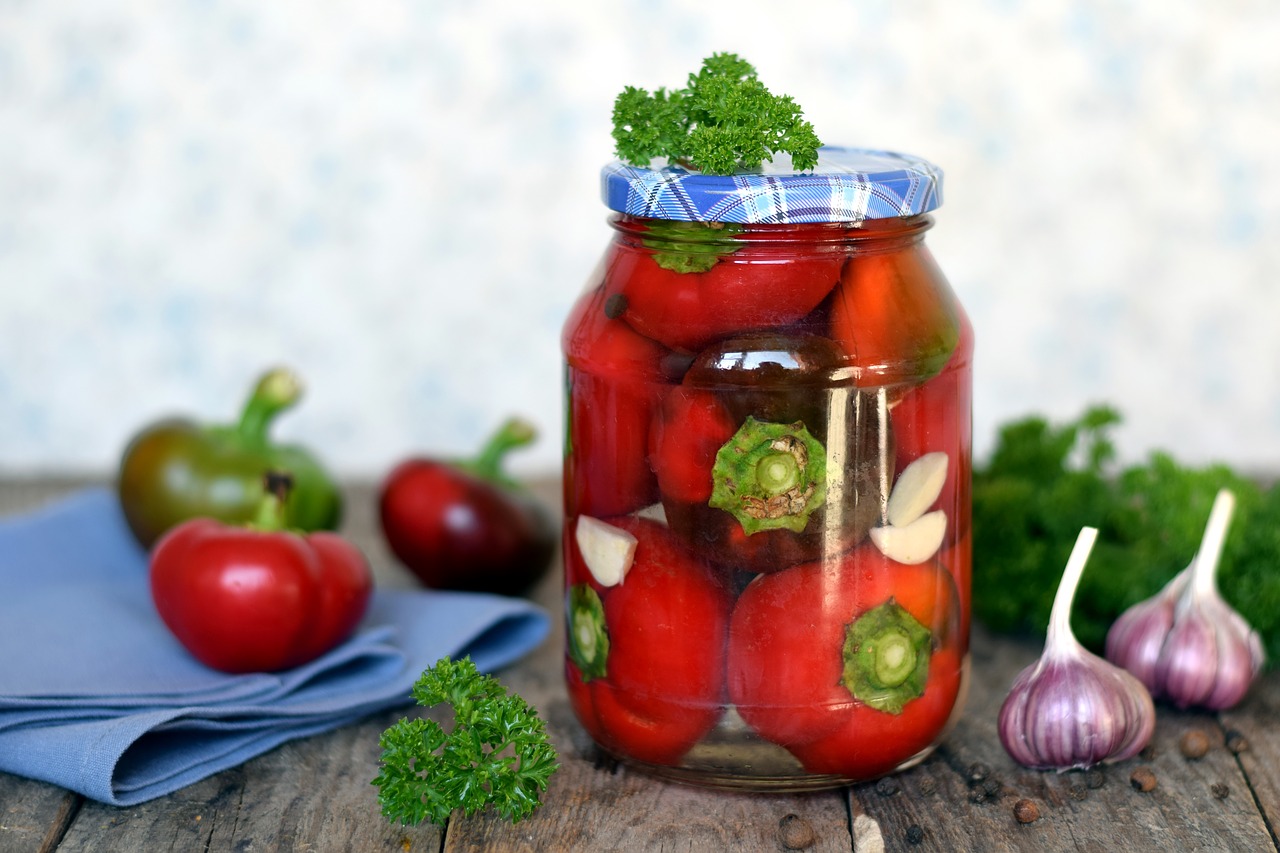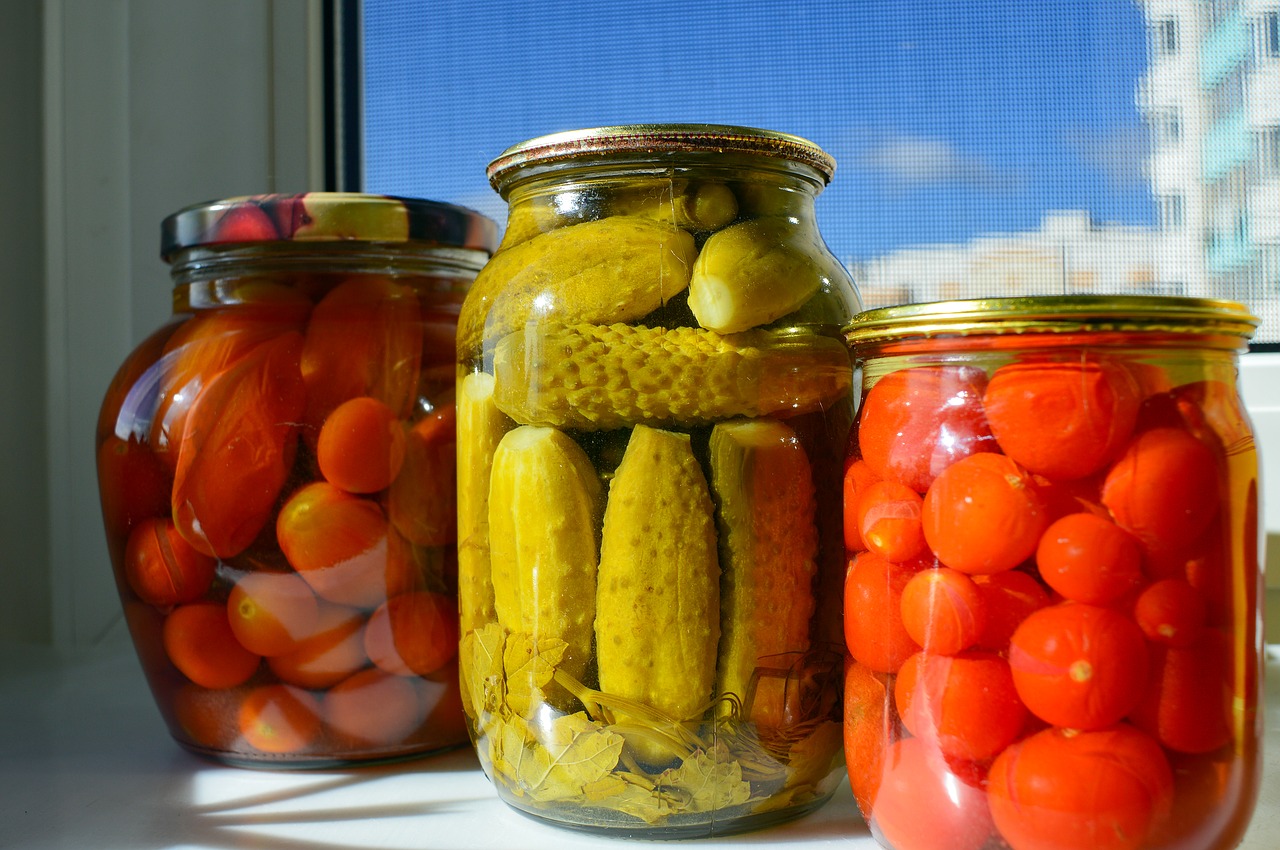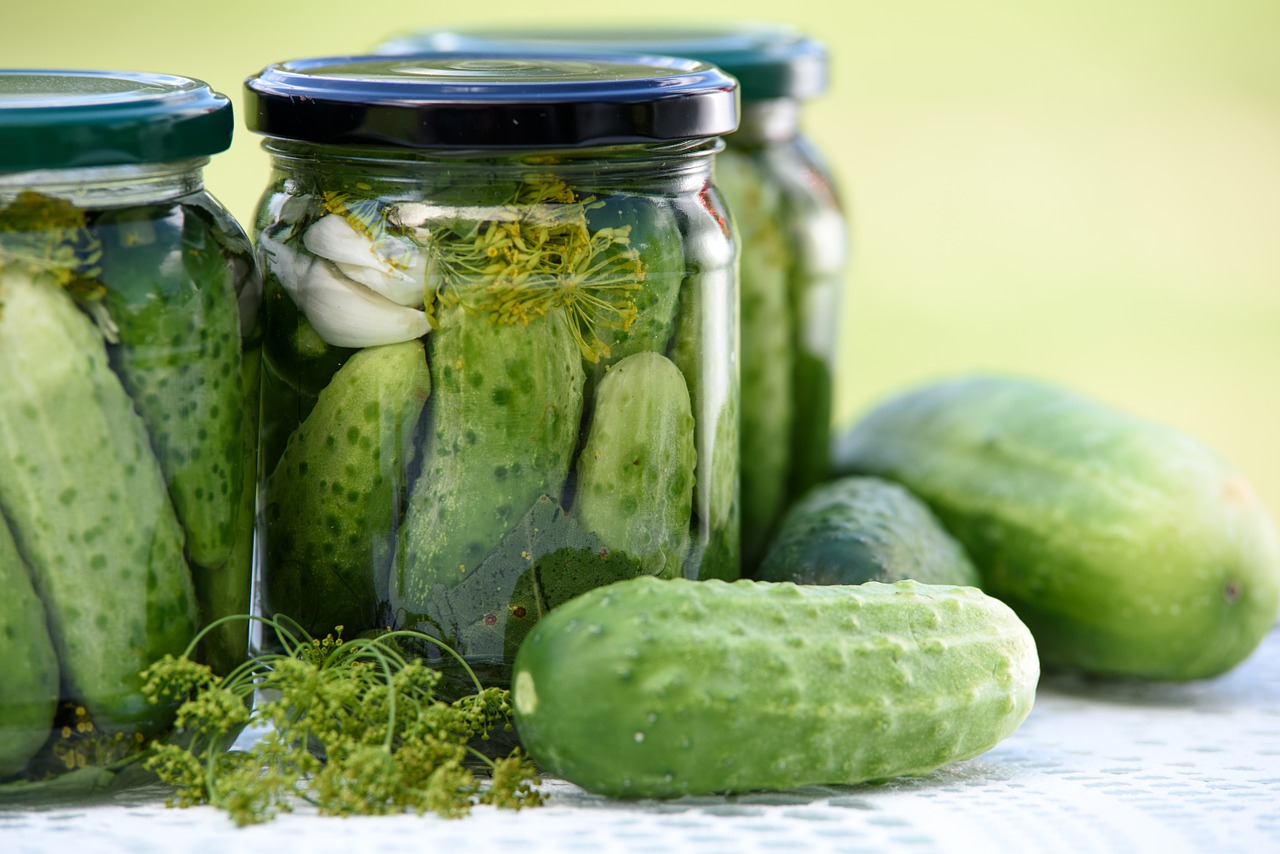Savoury and salty – that’s how we like them. Pickles are a great addition to our meals, known for their health-friendly probiotics and low calories. There are so many fruits and vegetables that you can pickle. Find out more about pickled food and the process of pickling itself.
How does the pickling process work?
Pickling is one of the oldest methods of preserving and storing food. It is a process of fermentation which takes place under the influence of special bacteria that break sugars down into lactic acid, preventing food from rotting. The correct acidification process depends on the content of sugar and water in the raw material as well as maintaining a temperature of 15-20 degrees celsius in the first 2-3 days of fermentation. In addition to lactic acid, a small amount of alcohol and acetic acid is produced, which improves the taste and smell of fermented products.
What can we pickle?
The most popular vegetables to pickle are, of course, cucumber and cabbage (white, red, Italian). While these are the most suitable vegetables for pickling, you can also successfully pickle beans, peppers, tomatoes, zucchini and beetroot.
When selecting veggies to pickle, you need to remember to choose the best quality produce that’s both washed and salted (this helps speed up the formation of lactic acid bacteria). Some vegetables, such as pumpkin, zucchini, should be diced before fermenting.
The most popular pickled foods
We can pickle many vegetables, but some of them are favoured more than others:
Cucumbers
These green veggies are definitely the most popular vegetable to pickle. They can be prepared as salty dill pickles or sweeter tasting gherkins. Pickles are a great addition to your sandwiches, hamburgers and salads.
Cabbage
Salty sauerkraut, hot pickled kimchi, or sweet cabbage slaw. Cabbage is a great veggie to pickle. You can use both red or green cabbage.
Beetroot
We all love the good earthy flavour of beetroot. This vegetable is high in many nutrients, like folate and manganese. It also consists of 80% of water which makes it perfect for pickling.
Peppers
These are a great addition to stir fries, chillies, and salads. Pickled peppers can be spicy or sweet. If you’re pickling hot peppers and want to reduce the heat, add some sweet capsicum to balance the spiciness.

What are the health benefits of pickled foods?
Pickled foods contain a lot of vitamins B1, B2, and B3, which regulate metabolism and facilitate the digestion of proteins, fats, and carbohydrates. They also make our skin smooth and strengthen hair and nails. Eating pickled foods can also increase our body’s absorption of iron (more about iron in our diet).
Pickled foods contain vitamins A and K as well as magnesium, calcium, phosphorus, and potassium. Contrary to popular belief, however, they don’t have more vitamin C than fresh fruit and vegetables. Most of the vitamin C content is lost during the pickling process. Fruits and vegetables lose calories during the fermentation process, as the sugar content drops and the amount of water increases.
Additionally, pickled veggies contain a lot of fiber, which helps with digestive processes and makes us feel full. This is a great way to maintain healthy weight.
Check out the top benefits of eating pickles:
- Full of antioxidants. Fresh fruits and vegetables contain antioxidants, and while we may lose them when cooking, antioxidants stay strong during fermentation. Additionally, you can find even higher amounts of antioxidants C and E in pickle juice.
As explained by Better Health Channel, a diet high in antioxidants may reduce the risk of many diseases (including heart disease and certain cancers). Antioxidants scavenge free radicals from the body cells and prevent or reduce the damage caused by oxidation. - Have a positive effect on our intestines. Pickles contain probiotics, which are positive live microorganisms that inhabit our intestines. They help to fight parasites, bacteria, and fungi, and increase our immunity. They are essential before, during, and after antibiotic treatments.
- Prevent blood sugar spikes. This is all because of the vinegar in pickle juice. Some research shows that the vinegar content in pickle juice can improve the body’s response to insulin and significantly reduce blood sugar levels after eating meals.
- Helps with sore muscles and cramps. According to some studies, pickle juice can be beneficial for sore muscles. Just ⅓ cup of the juice can soothe muscle cramps and soreness.
- Great vegetarian & vegan option. Doctors and dieticians recommend eating at least 5 serves of vegetables a day. Now here’s some good news – pickled foods are also vegetables! They may be slightly different to fresh ones, but they still contain many nutrients and count as vegetarian and vegan food.
Pickles when pregnant
During pregnancy, a woman’s taste changes. Normally inedible dishes become her favourites and strange flavour combinations don’t bother her. The body naturally feels what it needs and informs us about it through an increased desire for a given food. These strange flavour combinations or preferences for strongly flavoured foods can also be caused by nausea. Eating pickled foods can help suppress these unpleasant symptoms.
Cravings for sour foods like pickles, sauerkraut, and citrus can be caused by an increased demand for vitamin C. The body itself sends us information about what it needs, and in this case, the desire for acidic foods may also mean the need to increase the body’s immunity. Additionally, cravings for acidic foods can also be caused by iron deficiency, which is a very common problem during pregnancy.
Homemade vs. store bought pickled food
Pickling has been done at homes for centuries. For years, our great grandmothers have been preserving vegetables and fruits to make sure they last longer. This is not only a great tradition but also an amazing way to create tasty, healthy food that lasts for months. Thanks to pickling, you can enjoy seasonal vegetables all year long while also adding another salty/sweet flavour to them.
These days, you don’t have to prepare pickled food at home. Supermarkets offer a wide variety of jars with all kinds of fruits and vegetables pickled in different ways. But are these products better than traditional homemade pickles?
Store bought pickled food has its advantages that some of us value. Buying pickles is much faster, we can simply grab a jar from the store shelf and don’t need to spend time preparing it. This is a great choice for busy people. Additionally, there are plenty of options to choose from. You name it, you’ll find it!. From hot pickled jalapenos with chilli to delicious kimchi, pickle food producers know the best combinations and offer a wide range of flavours.
That said, it’s always better to prepare food at home as this allows us to be completely sure about the ingredients used. When buying pickles in the shop or supermarket, we need to make sure to check the labels. It’s unfortunate, but many producers add unhealthy ingredients to pickles, for extra flavours or colours. For that reason it’s always safer to prepare the food at home.
Why should I pickle at home?
As mentioned earlier, store bought pickles can be a good option for people with a busy lifestyle, however there are plenty of advantages of pickling at home. Check out the pros of pickling at home:
Know all your ingredients
Getting jarred pickles from the shop might be easy, but it may not be the healthiest option. Store bought pickles can contain ingredients that are added just to boost colours or flavours, for example sodium metabisulphite (223) or polyethylene sorbitan mono-oleate(433). That’s why it is always important to check the labels before choosing the pickles we like.
Pickling is easy
You don’t have to be a masterchef to pickle. The whole process is extremely easy and not that time consuming. All you need to do is follow a few easy steps, give your pickled food some time, and there you go, ready to eat!
Create some traditional flavours
Pickling is a tradition in itself. There are plenty of hundred years old recipes that can be continued by us. You can also find some modernised recipes with a hint of traditional flavours. You choose whatever you prefer.
It’s great for the environment!
Pickling foods can help prevent wasting foods as it lets you keep your products for longer without having to throw them out. You bought too many cucumbers or tomatoes? Why don’t you just pickle them before they get old?
Pickling also doesn’t require any modern technology and energy, it’s all natural.
Save all four seasons in the jar
The main advantage of pickling food is that you can make your products last longer. Thanks to that, you’ll be able to enjoy the flavours of seasonal fruits and veggies all year long.
Have food always available in your pantry
Don’t know what to cook tonight? If you have plenty of pickled products, you can always create something new. And because they last so long, you can collect as many pickle jars as you want, knowing they won’t go bad. Make a salad with some pickled tomatoes or add pickled chilli to your veggies and prepare a mexican feast.

Types of pickling methods
When you decide to pickle at home, the first thing you need to do is choose the right pickling method for the specific product you’re using. Here are the different methods of pickling:
Pickling in salt
This is the method that works best with fruit and vegetables that have a delicate texture and contain lots of water. You can use salt to pickle mushrooms, tomatoes, plums or strawberries. A typical example of this method is the well known sauerkraut. In this method, fermentation takes place by the growth of lactic acid bacteria in the juice that has leaked out of the salty product.
Pickling in brine
This is one of the most popular fermentation methods. It is perfect for pickling hard fruit and vegetables such as radishes, apples, carrots, cucumbers and young beets. The pickling process is carried out by mixing a product with water and salt, i.e. brine, which creates the appropriate condition for lactic acid bacteria to develop. Any juice or beer can be used instead of water to create the brine. After eating fermented products with this method, it is worth using the already fermented brine to create new pickled foods.
Pickling in fermented milk products
This method is very similar to pickling in brine, but in this case, fermented milk products are used instead of water. It can be sour cream or sour milk. This method works very well for pickling beets, blueberries, cucumbers, and carrots. Since you’ll be using a product that already contains lactic acid bacteria, the process is faster than others.
Kimchi
This is one of Korea’s national dishes and loved all over Australia. Many of us describe kimchi as a sauerkraut with chili, vegetables, and soy sauce, however, according to Koreans, all pickles are kimchi. For example, pickled cucumbers would be called water kimchi. Kimchi fermentation occurs by mixing fruit and vegetables with a paste made of onion, garlic, fruit, and spices. There is no single recipe for this paste, because every region and every family in Korea uses their own different combination to produce unique kimchi. It wasn’t until the 18th century that hot peppers were added to kimchi due to the increase in salt prices. Earlier varieties of kimchi contained virtually no hot spices at all. In Korea, each meal must contain one or more types of kimchi.
How to make pickled food?
Pickling is super easy! Even someone who isn’t an experienced chef can prepare delicious pickled fruit and vegetables. All you need to do is just follow a few steps:
- Choose your product. This is your first step! You can pickle most veggies. Vegetables that are good eaten raw, can just be washed, sliced, and placed in a jar. Other veggies should be steamed or cooked before pickling.
- Choose your pickling method. After deciding which fruit or veggie you will pickle, choose the brine you would like to use. A basic plain white vinegar with some pickling spices is a great starting point for beginners. Basic brine consists of vinegar, water, sugar, and salt. If you have some leftover pickles in the fridge, you can also use that brine to pickle your next product.
- Put your veggies in the jar. Now all you need to do is slice your products and place them in a jar. Leave a little bit of space to make sure the brine can cover them all.
- Pour brine into jars. The next step is to boil your brine ingredients and pour over the veggies or fruit in the jar. After filling all the jars, put the lids on and let the jars cool down.
- Give it some time. You can see the results of pickling even after 24 hours, however it is best to wait at least 2-3 days for the flavours to develop.
Top tips for making pickled food at home
As you see, the process is very simple and not at all time consuming. Have a bit of a play with it and experiment with different flavours to explore the amazing world of pickled veggies and fruit. Before doing so, don’t forget about these top tips for pickling:
- Pick the best products. When pickling cucumbers, for example, choose ones that are about 10 cm in size with intense green skin, thick warts, and an oblong shape (not barrel-shaped).
- Don’t over boil the water. For proper fermentation conditions and good taste, try not to boil the brine too much but slightly simmer it.
- Choose the right containers. The jars and caps you use must not have rusty coatings as iron can cause the veggies to rot.
- Wait with adding salt. When preparing brine for fermentation, don’t pour the salt into boiling water. Wait a little bit and then add the salt when the water has slightly cooled.
- Watch your jars. When storing your pickles, try to observe any changes in the jar. If white sediment appears on the surface, just stir the contents of the jar. A white coating is not a sign of spoilage. If green, blue or pink mold or silage appears on the surface, however, or your pickles have a slimy consistency or unpleasant odour, then they should be disposed of immediately.
- Jars with pickles after opening. Keep the jars that you open frequently in the refrigerator. Those that you rarely look at can be stored at room temperature. Remember that the higher the temperature, the faster the fermentation, but in high heat the brine can also taste worse or simply go bad.
We also recommend joining this Facebook Group about pickled food in Australia. Click here.





I’ve never really tried pickled peppers before. It would be lovely if you share recipes on pickles. Something easy and fun to make.